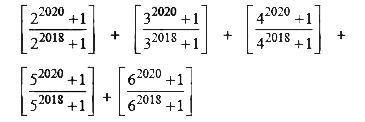Least Integer Function:
We know that any real number x can be expressed as following x= [x] + {x}, where [x] is an integer and 0≤{x}<1. We define [x] as the greatest integer less than or equal to x or integral part of x and (x} as the fractional part of x:
Suppose for any real number x we write x = [x]+{x}, where [x] is integer and 0≤{x}<1. We define (x) as the least integer greater than or equal to x. For example:
(2.36) = 3
(-13.11) =-13
(4)=4
Clearly, If x≠I, then (x)=x -{x}+1
if x ∈ I, then (x) = [x] +1.
We can also define that ξn(n,n+1]⇒(x)=n+1, where n∈I.
The domain of definition of the function f(x)=1√x−{x} is
A
I
B
R~I
C
(0,∞)
D
ϕ
Text Solution
The correct Answer is:D
|
Topper's Solved these Questions
- FUNCTIONBOOK - FIITJEECHAPTER - FUNCTIONEXERCISE - MATCH THE COLUMNS
6 Videos
- FUNCTIONBOOK - FIITJEECHAPTER - FUNCTIONEXERCISE - NUMERICAL BASED
3 Videos
- FUNCTIONBOOK - FIITJEECHAPTER - FUNCTIONEXERCISE - ASSIGNMENT PROBLEMS (OBJECTIVE) Level-II
20 Videos
- ELLIPSEBOOK - FIITJEECHAPTER - ELLIPSEEXERCISE - NUMERICAL BASED
4 Videos
- HEIGHTS & DISTANCE BOOK - FIITJEECHAPTER - HEIGHTS & DISTANCE EXERCISE - ASSIGNMENT PROBLEMS (OBJECTIVE) LEVEL-II
20 Videos
Similar Questions
Knowledge Check
Least Integer Function:
We know that any real number x can be expressed as following x= [x] + {x}, where (x) is an integer and 0≤{x}<1. We define [x] as the greatest integer less than or equal to x or integral part of x and (x} as the fractional part of x:
Suppose for any real number x we write x = (x) - 0, whore (x) Is integer and 0≤(x)<1. We define (x) as the least integer greater than or equal to x. For example:
(2.36) = 3
(-13.11) =-13
(4)=4
Clearly, If ξnl, then (x)-{x]
if x ∈ l, then (x) = [x] +1.
We can also define that ξn(n,n+1]⇒(x)=n+1, where n∈I.
The range of the function f(x)=1√(x)−[x] isAϕB{1}C{1√n,n∈N}D(1,∞)Let [x] be the greatest integer less than or equal to x, for a real number x. Then the following sum

is-A80B85C90D95Let [x] be the greatest integer less than or equal to x, for a real number x. Then the equation [x2]=x+1 has
Atwo solutionsBone solutionCno solutionDmore than two solutions
Let f(x)andg(x) be defined by f(x)=[x]andg(x)={0,x∈, integer and x2 ,otherwi, where [x] denotes the greatest integer less than or equal to x. Then
View SolutionSolve (x−2)[x]={x}−1, (where [x]and{x} denote the greatest integer function less than or equal to x and the fractional part function, respectively).
View SolutionIf the sum of the greatest integer less than or equal to x and the least integer than or equal to x is 5, then the solution set for x is
View SolutionIf [x] denotes the greatest integer less than or equal to x for any real number x. Then, limx→∞[n√2]n is
View SolutionIf the sum of the greatest integer less than or equal to x and the least integer than or equal to x is 5, then the solution set for x is
View Solution
